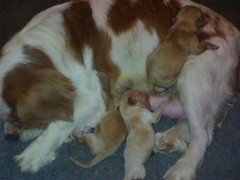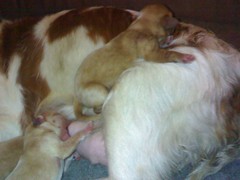-
If you're a past member of the board, but can't recall your password any more, you don't need to set up a new account (unless you wish to). As long as you recall your old login name, you can log in with that user name then select 'forgot password' and the board will email you at your registration email, to let you reset your password.
You are using an out of date browser. It may not display this or other websites correctly.
You should upgrade or use an alternative browser.
You should upgrade or use an alternative browser.
The puppies are here!
- Thread starter Thelly
- Start date
Lisa_T
Well-known member
Congrats and best of luck with the pups.... and sorry about the one that didn't make it.
Is it at all possible that both Fred and Ginger had a ruby parent? Hmm, maybe not.. I know wholecolour always dominates over parti, and I imagine both Fred and Ginger would have much more ruby if that was the case...I know a wc/pc mating can result in a wholecolour litter (Amber's parents are BT/Tri- the litter was all BT and Amber the only ruby) but don't know if the same can result in a parti...
Anyone?
Is it at all possible that both Fred and Ginger had a ruby parent? Hmm, maybe not.. I know wholecolour always dominates over parti, and I imagine both Fred and Ginger would have much more ruby if that was the case...I know a wc/pc mating can result in a wholecolour litter (Amber's parents are BT/Tri- the litter was all BT and Amber the only ruby) but don't know if the same can result in a parti...
Anyone?
Lisa, here's a table on colour possibilities. It wouldn't matter what the parents were -- if Fred were the dad, a blenheim x blenheim cross will always produce only blenheims:
http://www.fckc.com/sante/genetique/possibilites.html
On retrospect, I do feel it extremely unlikely a ruby could be the father -- I just do not think this man had a variety of dogs or was a large scale breeder and I think these were his only two cavaliers. As the puppies do not seem to be blenheims, it is far more likely that they are mixes of some sort. A few weeks and it should be pretty clear if they are cavaliers or mixes. But right now I would be homing these as cavalier mixes until I am very sure this is not the case -- it makes more sense to assume they are mixes on the available evidence!
But right now I would be homing these as cavalier mixes until I am very sure this is not the case -- it makes more sense to assume they are mixes on the available evidence!
http://www.fckc.com/sante/genetique/possibilites.html
On retrospect, I do feel it extremely unlikely a ruby could be the father -- I just do not think this man had a variety of dogs or was a large scale breeder and I think these were his only two cavaliers. As the puppies do not seem to be blenheims, it is far more likely that they are mixes of some sort. A few weeks and it should be pretty clear if they are cavaliers or mixes.
loveisokay
Well-known member
Is that actually 100% guaranteed what should happen with something like genes, though? I honestly do believe genes have been completely over simplified, for example many people think it looks like Gg or gg or GG & so on. I'd be very surprised if it was as easy to understand as a table. If size can skip generations, I don't see why colour can't.
Obviously, they could still be a mix, but if they were a lab cross, wouldn't Ginger have had a very difficult time whelping?
Whatever they are, they are bloody cute, though.
Obviously, they could still be a mix, but if they were a lab cross, wouldn't Ginger have had a very difficult time whelping?
Whatever they are, they are bloody cute, though.
brid kenny
Well-known member
Exactly, it must be great watching them!
Barbara Nixon
Well-known member
Perhaps dad is an golden Irish Mountain Climber. The puppies do seem to have the colouring nearer to that of a yellow lab, as isn't the ruby's red quite intense, even at birth (as opposed to Blenheims who darken up) ?
The puppies do seem to have the colouring nearer to that of a yellow lab, as isn't the ruby's red quite intense, even at birth (as opposed to Blenheims who darken up) ?
loveisokay
Well-known member
Perhaps dad is an golden Irish Mountain Climber.The puppies do seem to have the colouring nearer to that of a yellow lab, as isn't the ruby's red quite intense, even at birth (as opposed to Blenheims who darken up) ?
Nope. Mine was very "golden" looking at 8 weeks old.
Genes always work out this way with colour, precisely because the way genes work for colour in this breed is known exactly (simple inheritence always means you can know the likely and sometimes the exact results from certain matings for certain characteristics from health issues to physical characteristics. When you have a blenheim, it got all recessive genes to create that colour combination. So any cross cannot produce the dominant genes that might give a different colour because neither parent has any of the dominant colour genes to pass on to offspring. Some other colours can produce diffrent colours than the parents depending on the combination of dominant and recessive genes it has, and how it passed them on. The diagram link I posted for color gives every possible combination depending on whether a certain colour was dominant or recessive. But as you can see on the chart, two blenheims will always and can only ever produce blenheims.
With a smaller breed dog whelping puppies from a larger breed sire, mother nature tends to compensate by making the puppies a smaller size though they may grow to a larger dog! Sometimes the puppies will be too big too whelp and a C-section is needed -- but this can happen with two cavalier parents too if a puppy or two is particularly large. A lot of times singleton puppies get too big to whelp and a C-section is needed -- as they hog all the nutrients themselves!
With a smaller breed dog whelping puppies from a larger breed sire, mother nature tends to compensate by making the puppies a smaller size though they may grow to a larger dog! Sometimes the puppies will be too big too whelp and a C-section is needed -- but this can happen with two cavalier parents too if a puppy or two is particularly large. A lot of times singleton puppies get too big to whelp and a C-section is needed -- as they hog all the nutrients themselves!
loveisokay
Well-known member
No, I completely understand every bit of that & did before you said that. I was questioning whether that chart & the understanding of recessive & dominant genes, as taught in high school when we were all about 13, is a little bit elementary. I've studied science subjects to A level & even that was elementary to what the actual facts were outside of the taught syllabus in schools - in fact, most of my teachers would get quite distraught at the over simplification of what we were taught as it essentially meant most of it was wrong. I appreciate, that as a general rule, it may be true but surely you cannot rule out anomalies. I was asking whether it is ALWAYS ALWAYS the case as I highly doubt that, from what I know outside of breeding from my studies.
Yes, it is ALWAYS THE CASE.  This is a very well understood area of genetics and for this particular colour, it can never, ever genetically be otherwise than that blenheims are ALL recessive and a crossing of two all recessive dogs can therefore ONLY produce all recessive puppies because there is simply NO dominant colour gene to pass on. Full stop, cannot genetically be otherwise. The ONLY colour thus associated with this mix is blenheim.
This is a very well understood area of genetics and for this particular colour, it can never, ever genetically be otherwise than that blenheims are ALL recessive and a crossing of two all recessive dogs can therefore ONLY produce all recessive puppies because there is simply NO dominant colour gene to pass on. Full stop, cannot genetically be otherwise. The ONLY colour thus associated with this mix is blenheim.
Barbara Nixon
Well-known member
Coat colour genetics are indeed much more complicated than the mere B, b, S and s , for markings colour and white showing. For instance there are thought to be four alleles for the white 'spotting ' gene, ranging from S for no white, s (little i) for Irish spotting, where the white areas don't go over the back, s (little p) for piebald, as in cavaliers and s (little w) for mainly white. These are in descending order of dominance. In other breeds, genes, affect markings like black masks (gsds) , merle (collies), intensity of colour (labs) etc, but the basic inheritance of white showing is straightforward. If they don't carry the S allele for no white, then white will show. Therefore neither Blenheim parent can carry this and pass it on.
Ani nteresting point is that our particour dogs are not actually white with black, red or tan markings , but coloured dogs with white 'leaking' through.
Ani nteresting point is that our particour dogs are not actually white with black, red or tan markings , but coloured dogs with white 'leaking' through.


